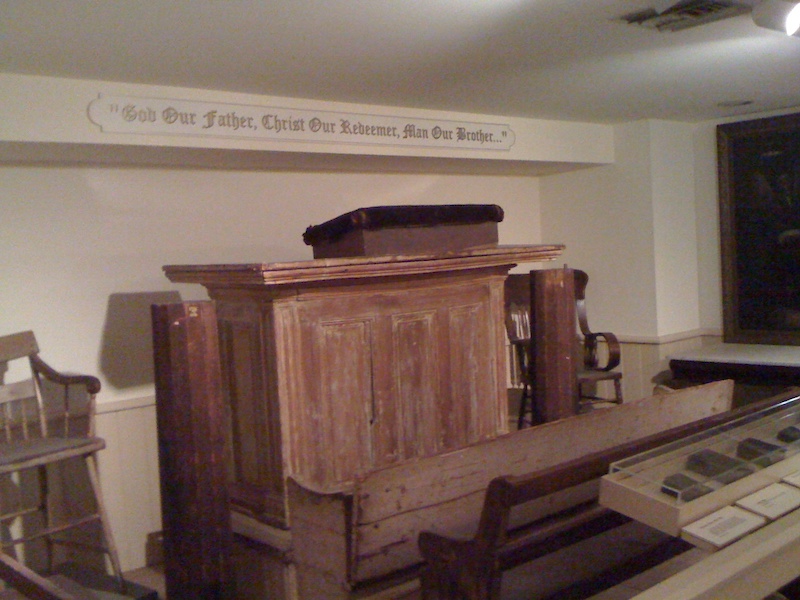Daily Office Readings for the feast of Richard Allen, March 26, 2021: Psalm 136:1-2, 10-16, Exodus 6:1-11, Acts 12:1-11, John 7:25-31
Our reading from the Hebrew scriptures today introduces us to God’s call to Moses to lead his people out of bondage–a fitting tribute to the Moses-like call God whispered into the ear of Richard Allen. We tend to think of Absolom Jones first, when we think about the history of the African-American church experience, but Richard Allen was the other half of a duo that was key to this chapter of American history.
Richard Allen was born a slave, in 1760, in Philadelphia. (At that time, slavery was legal in Pennsyvania.) He, along with his family, was sold to a man in Delaware, and he had the good fortune to be sold to a man who later had a religious conversion and believed that, on the Judgment Day, slaveowners would be found lacking. He allowed Richard to work towards his own freedom by driving a wagon and cutting wood.
Richard had his own Christian conversion experience at age 17 by the same itinerant preacher, and quickly rose to be a preacher of stature in his own right, even recalling that sometimes he preached in his sleep or woke up preaching. He began traveling the Methodist preaching circuits in 1781, first in Delaware, and eventually worked his way back to Philadelphia by 1786, becoming a member of St. George’s Methodist Church, where he renewed his friendship with Absolom Jones, whom he first met in Delaware. At that time St. George’s was an integrated church…somewhat. Although African-Americans were members, sometime in the 1780s the church leadership created segregated seating in chairs around the periphery of the building. This was the beginning of the racial tension that would throw Allen and Jones together for the next chapter of their lives.
In 1787, some new pews were built, and several of the African-American parishioners, including Absolom Jones, came to worship and sat in them. When they were told by a trustee to vacate them, they stayed until they were finished with their prayers, and walked out. Richard Allen had been independently been thinking it was time for he and his fellow parishioners of color to move out of St. George’s anyway, so he joined forces with Jones and was a key figure in the formation of the Free African Society, and, as they say, the rest is history. Jones would go on to establish a new congregation in the Episcopal Church, the African Episcopal Church of St. Thomas, in Philadelphia, in 1794. Allen, forever a Methodist at heart, went on to establish the Bethel African Methodist Episcopal Church, that same year, also in Philadelphia. By 1816 Bethel and three other congregations would form the core of a new denomination, the African Methodist Episcopal (AME) Church.
One of the things we are all being asked to do in the Episcopal Church, as we get more in touch with the systemic racism that permeates America and American Christianity, is to open our eyes to the “traces of the trade”–the remnants of how the injustices of slavery and racism still linger almost imperceptibly in our American fabric. Decades ago, Martin Luther King remarked that “It is appalling that the most segregated hour of Christian America is eleven o’clock on Sunday morning.” Although we might be able to point to a congregation here and there that is more racially diverse, really, very little has changed in America in this regard. It’s important to understand that this lived-out segregation in our churches has little to do with cultural like-mindedness, and a great deal to do with the fact white Americans made Americans of color unwelcome in their churches a long time ago, so, like Moses leading the Israelites, more contemporary Moses figures like Absolom Jones and Richard Allen led their congregations onward–and we still live with the stain on this part of our American fabric. As Jemar Tisby writes in The Color of Compromise: The Truth about the American Church’s Complicity in Racism:
“Christian complicity with racism in the twenty-first century looks different than complicity with racism in the past. It looks like Christians responding to ‘black lives matter’ with the phrase ‘all lives matter.’ It looks like Christians consistently supporting a president whose racism has been on display for decades. It looks like Christians telling black people and their allies that their attempts to bring up racial concerns are ‘divisive.’ It looks like conversations on race that focus on individual relationships and are unwilling to discuss systemic solutions. Perhaps Christian complicity in racism has not changed after all. Although the characters and the specifics are new, many of the same rationalizations for racism remain.”
What does giving up the complicity look like?
Maria Evans splits her week between being a pathologist and laboratory director in Kirksville, MO, and gratefully serving in the Episcopal Diocese of Missouri , as the Interim Pastor at Christ Episcopal Church, Rolla, MO.

